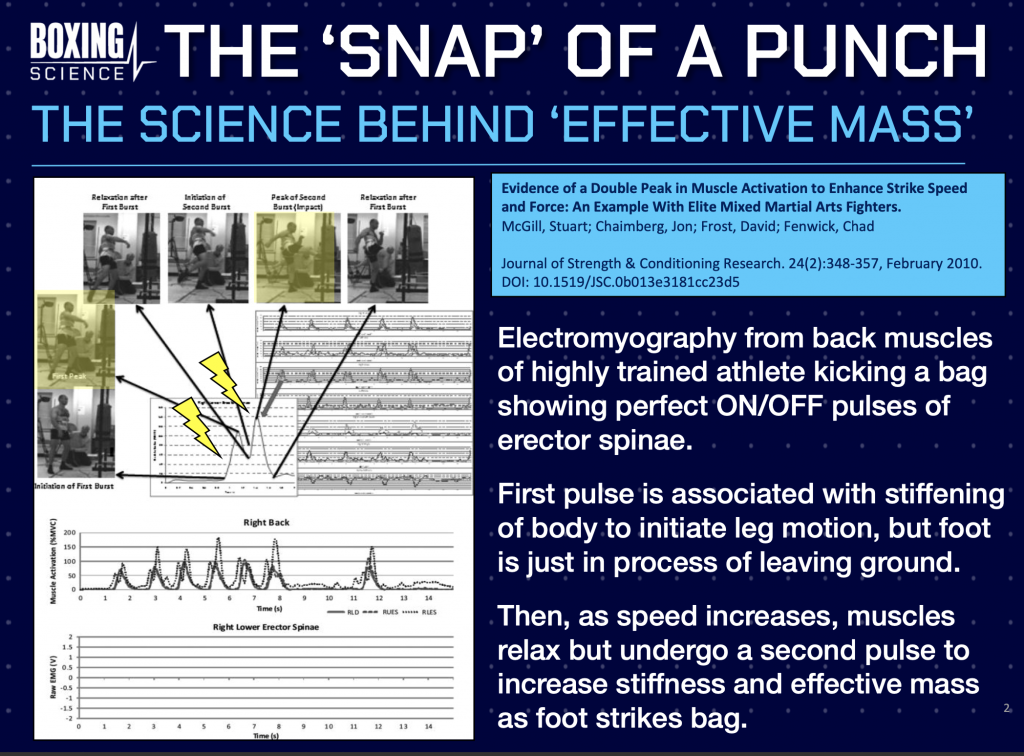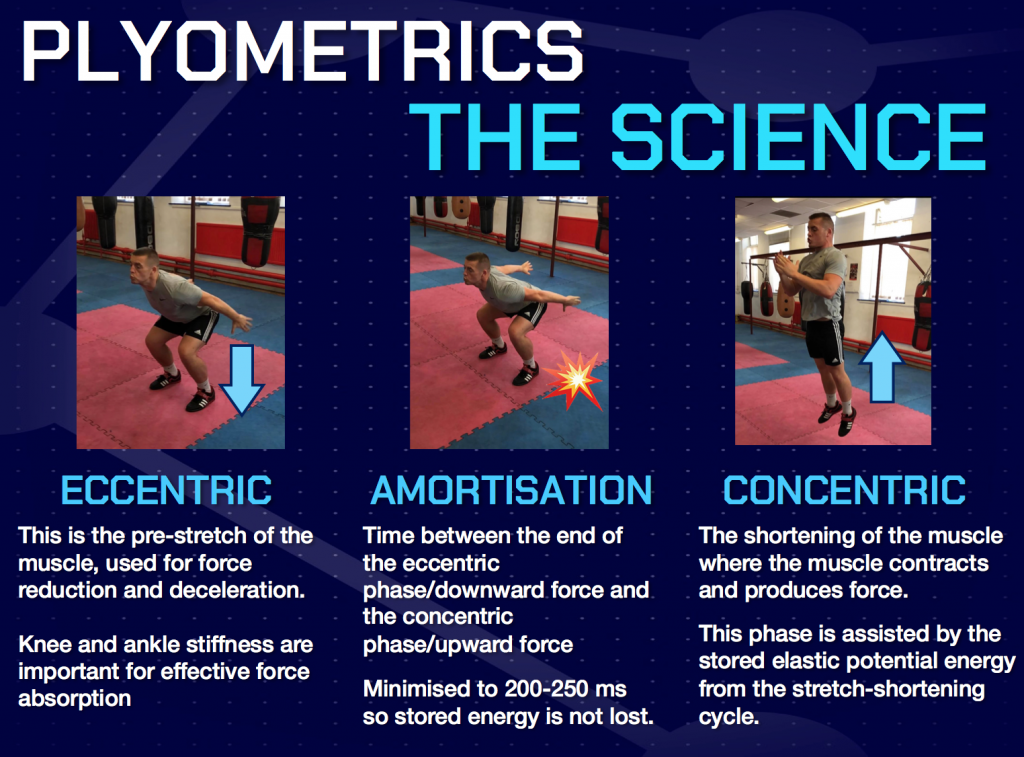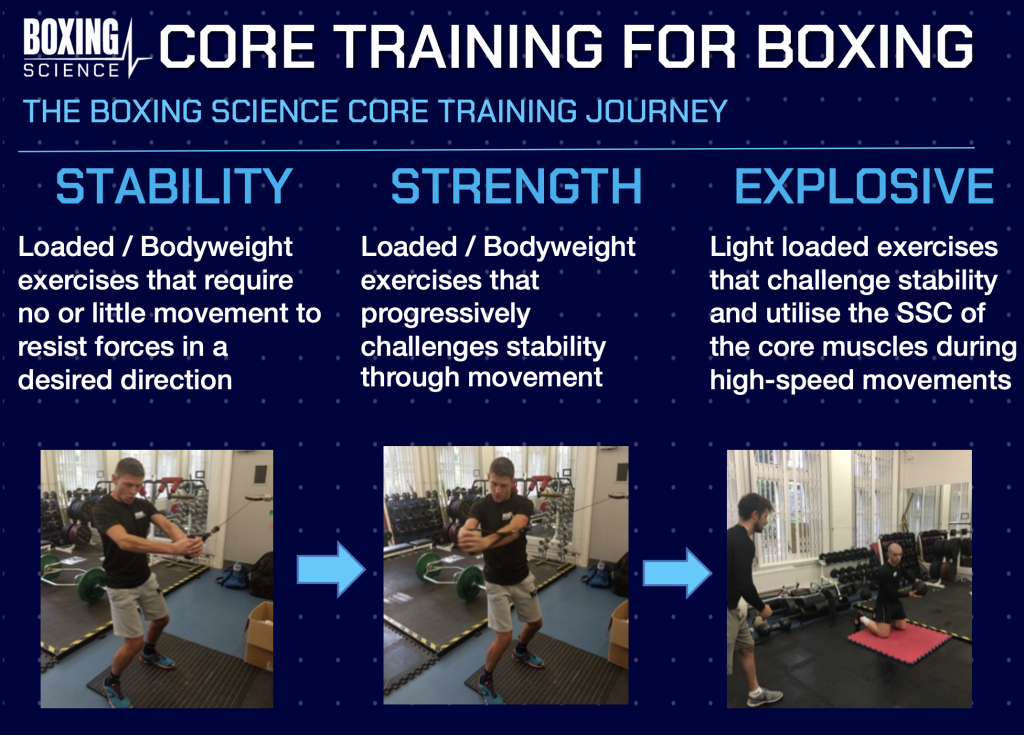ROTATIONAL STRENGTH AND POWER FOR BOXING: THE PALLOF PRESS
The Pallof Press is a popular core exercise to improve rotational strength, stability and power.
In strength and conditioning, this exercise is categorised as an anti-rotation core exercise.
Anti-rotation is an important core function that can feature in many aspects of various sports and plays a pivotal role in boxing performance due to the frequent rotation performed by boxers during competition.
As such, the main points of discussion within this article include:
- The benefits of the Pallof Press for boxing.
- The importance of anti-rotation for a boxer.
- An outline of the core training journey we coach our boxers through.
- The Pallof Press variations we program to compliment each phase of the core training journey.
THE BENEFITS OF THE PALLOF PRESS
As mentioned above, the Pallof Press primarily targets anti-rotational properties of the core. This exercise can also be adjusted to develop rotational strength and power which is an essential quality for any boxer.
This exercise also targets the obliques and lateral stabilisers, which you may have guessed play a substantial role in anti-rotation, but are also key to resisting lateral flexion.
Resisting lateral flexion is important for boxers to avoid side bending when punching which can often leave them in a vulnerable position for counter punches as well as causing a loss of balance.
An often overlooked benefit of the Pallof Press for boxers is the engagement of the posterior shoulder when performed correctly.
Posterior shoulder recruitment is something we try and include wherever we can, as boxers are often extremely anterior dominant due to prolonged periods of time in the boxing stance as well as performing thousands upon thousands of punches in training.
This anterior dominance usually leads to the development of a rounded posture which can significantly impair shoulder range of motion, compromise shoulder stability and increase the risk of shoulder injury and irritation.
Synchronous recruitment of the posterior shoulder and core during the Pallof Press can also improve the effectiveness of this recruitment pattern during a punch.
Research by Mcgill et al (1), highlights the presence of a double peak in muscle activation during a punching action.
This means that on impact we see a noticeable spike or peak in the activation of the muscles around the hand/wrist, shoulder, core and lower body.
This is termed effective mass and serves to maximise impact at the end range of a punch.
Considering this, if we can promote the simultaneous recruitment of the posterior shoulder and muscles of the core during both static and dynamic movements we can help improve stiffness of the punching arm at end ranges, optimising force transfer to towards the target.
WHAT ABOUT THE SIDE PLANK?
The side plank is a staple in many boxing gyms core training routine, and is a great exercise to use, especially with younger athletes or groups of athletes, to develop overall core stability and endurance.
However, the effectiveness of this exercise is compromised by a boxer’s tendency to overload their strong shoulders in fatiguing conditions.
Side planks performed to fatigue or for an extended period of time will often end up becoming a shoulder burn out more so than an exercise for developing the obliques and lateral stabilisers of the core.
Whilst we still program the side plank, we do not view it as an optimal exercise for developing anti-rotation/rotational functions of the core.
Instead, we will place much greater emphasis on exercises that enable boxers to maximally recruit the region of the core we are aiming to develop.

ANTI-ROTATION – IMPORTANCE FOR BOXERS
We know that rotational power through the core is essential for boxers when putting together fast combinations or when delivering punishing power shots to the opponent such as hooks and uppercuts.
A prime example is Gervonta ‘Tank’ Davis’ most recent knockout:
The forceful core rotation we see in punches like the one above is quick and subtle yet can make all the difference between laying an opponent flat on his back or merely stunning him.
This is because a pre load or stretch through the core before rotating back towards the target allows us to exploit a neuromuscular phenomenon, known as the stretch shortening cycle.
The stretch shortening cycle acts in three main ways to provide superior force and impulse compared to performing a dynamic movement without a prior stretch.
These include the storage and reutilisation of elastic energy, availing of the stretch reflex and allowing more time to develop force.
We know that impulse is dictated by force and time, therefore, if we can give ourselves more time to generate force using a pre-stretch we can improve the impulsiveness of the punching arm and maximise punch impact.
The main benefit of training anti-rotation, therefore, is the improvements we can obtain in the stretch shortening cycle function of the core region.
Enhanced stretch shortening cycle function through anti-rotation exercises is usually derived from an improved ability of the oblique muscles to withstand forces from a given direction, facilitating improvements in eccentric utilisation.
Anything eccentric related usually refers to the absorption of force i.e how well can our muscles and tendons tolerate and utilise rapid pre-loading or pre-stretching before reproducing that force in the desired direction.
These improvements in stretch shortening cycle function will also help with punch efficiency. Essentially, we can minimise the effort/physical cost required to deliver combination punches or power punches through optimising stretch shortening cycle function of the core and lower body.
Improvements in punch efficiency will enable fighters to retain a greater percentage of their punch power throughout a fatiguing bout.

Anti-rotational movements are also a great way to develop high levels of strength endurance in the core muscles responsible for rotation.
Endurance throughout all regions of the core will help with maintaining posture and punching form throughout the duration of a bout.
This will also enable us to establish solid foundations of stability for future training phases where the emphasis will transition to rotational strength and explosiveness as fight night beckons.
This is what we refer to as our core training journey which we have implemented with great success over the years to comprehensively develop the core region, enabling our boxers to punch harder, faster and more efficiently.
THE BOXER’S CORE TRAINING JOURNEY
The importance of having the ability to express explosiveness through the core for boxing is obvious.
Combination punching, power punching and even counter punching all require the rapid recruitment of the core to transmit force from foot to fist.
With that said, as coaches it is important to gradually progress towards dynamic core exercises.
Why?
We know that boxers develop inefficient recruitment patterns from years of exposure to the habitual elements of boxing.
The boxing stance, the rounded guard posture, thousands of punches thrown and hundreds of miles covered on the road all contribute to restrictions in mobility around the shoulder, hips and thoracic spine.
Restrictions in one region usually mean unwanted compensation through other regions during repetitive dynamic actions.
A common area of compensation for boxers is the lower back, specifically the Quadratus Lumborum (QL).
When throwing punches, especially in fatiguing conditions, boxers are prone to recruiting the QL rather than their glutes and core to extend the hips and transmit force from foot to fist.
Furthermore, the common core training methods used in boxing gyms such as sit ups. crunches and leg raises may only serve to compound the issue as boxers will likely continue their compensation tendencies during these movements.
So, despite having rock solid abdominals and being able to throw 100+ uppercuts in 30 seconds, immediate exposure to explosive core training in a strength and conditioning setting will likely only contribute further to existing lower back discomfort among boxers.
Considering this, the core training journey we implement at Boxing Science consists of three distinct phases:
- Stability
- Strength
- Explosiveness

- STABILITY
This phase is characterised by lightly loaded/bodyweight movements that involve little to no movement and challenge the athlete’s ability to resist forces in a given direction.
During this phase we are targeting one of the primary functions of the core, as a whole, which is to prevent inefficient movement or leakages throughout the kinetic chain when transmitting force from foot to fist.
Examples of exercises in this phase include hold variations such as your standard plank holds, farmers holds and supine core holds.
We also frequently target core proprioception towards the latter part of this phase through pallof perturbation techniques.
Usually these exercises are performed for time, anywhere between 20-40s for 3-4 sets.
2. STRENGTH
Once the foundations of stability and endurance have been established in the initial phase of our core training journey, we then look to emphasise strength development through the core.
Pallof rotations, landmine rotations, deadbugs, weighted leg lowers, straight arm, straight leg sit ups and farmers walks are all examples of exercises suited to this phase.
With these exercises we are challenging the athletes ability to maintain core stability during movement and perhaps under load.
We will tend to prescribe reps rather than sets during this phase as sets for time can cause the athlete to ignore technique in order to just get through the set.
If we can cue the athlete to focus on mastering each rep for a given rep range then this will likely lead to improved quality of the set.
Rep ranges are usually between 8-10 Reps each side or 10-12 Reps total for 3-4 Sets.
3. EXPLOSIVE
Our last phase of the core training journey focuses on absorbing and producing force in a dynamic fashion.
This phase usually coincides with speed-strength/taper phases of our strength and conditioning program as training becomes more specific closer to competition.
During this phase the aim is to overload the stretch shortening cycle through speed and light loads, primarily using medicine balls.
Exercises that we use this phase include, kneeling medicine ball slams, Pallof rotations, kneeling rotational throws and explosive landmine rotations.
We will often prescribe lower rep ranges during when peforming these explosive movements to maintain maximal intent and movement speed throughout each set.
Reps x Sets: 5-8 each side x 3-4 sets
PALLOF PRESS VARIATIONS
We have discussed the importance of anti-rotation and rotation for boxing and have also outlined the our core training journey.
But how can we manipulate the Pallof press to target the adaptations were looking to achieve in each phase of the core training journey?
The remainder of this article will outline the Pallof variations we use during each phase of the core training journey.
Stability
To improve rotational stability Pallof hold variations can be used to great effect.
Two variations that we include often are standing and kneeling manual resistance Pallof holds.
The main coaching points that should be used to maximise the effectiveness of these type of holds include:
Set up with your feet hip width apart, slight bend in the knees and hips, keeping your torso upright.
Pin the shoulders back and down, keeping the chest up. Shrugging of the shoulders is a common error we see when boxers perform this movement, as they will try to engage this strong muscle group to take over from the smaller, perhaps less developed core muscles.
Finally, the head should be central aligned throughout and the athlete should focus on actively engaging the core to resist rotation.
This kneeling variation will intensify the recruitment of the core as a result of removing the strong base of support of the lower body.
The same coaching cues apply to this exercise as the standing variation.
Reps x Sets: 3 x 3-5 secs holds each side x 3-4 sets.
STRENGTH
The most common movement we program to improve rotational strength is the Pallof Press.
This is essentially the baseline core exercise for improving rotational strength in most S&C programs.
Again, the key mistakes to avoid when performing this exercise include shrugging of the shoulders, failing to keep the head neutral and chin tucked.
Also, an important coaching point is to make sure that the band wrapped around the outside hand and not the hand nearest to the pole. This will help minimise the stress and recruitment of the pectorals and allow the athletes to engage his/her core to a greater extent.
The difficulty of this exercise will depend on how far you are away from the rack/pole.
To increase the difficulty simply set up further away from the rack to create more tension on the band. We recommend this way of progression rather as heavier bands will increase the input from the shoulders and pectorals.
We can also progress this exercise by adding complexity using variations such as the one below:
Switching from a standard bi lateral stance to a split stance will reduce the base of support available to the athlete and create even more of a stability challenge.
Additionally, the split stance will facilitate increased glute medius recruitment which is an essential muscle for lateral hip stability.
This can also tie in with the benefits of synchronous muscle group recruitment for enhancing effective mass at the end range of punches which we mentioned previously.
To make this more of a dynamic movement where we rapidly switch from a bi-lateral to a uni-lateral stance whilst remaining stable throughout the core, we can perform a Pallof split-jerk:
During this phase we can also build on proprioception work performed in the first phase.
This will challenge the core’s ability to adjust to rapid changes in length and tension and remain stable whilst having to make these adjustments.
Heres an example of how we can integrate some proprioception into the Pallof press:
When performing proprioception exercises such as this one the tendency to shrugg the shoulders will be harder to resist.
Therefore it is important to cue the athlete to pin his/her shoulder blades back and down and to keep the chest tall.
Additionally, this exercise will really challenge the boxer’s ability to maintain core engagement and to keep the arm rigid. As such, it’s vital to remind the athlete of these cues when performing this exercise.
Another variation we can also incorporate into this phase is the one below:
This variation of the Pallof press essentially combines aspects of both strength AND stability.
To get the most out of this movement, make sure to observe the lower body, cueing the athlete to keep his/her hips and knees stable, avoiding any internal rotation.
This will really engage the lateral stabilisers of the core as well as the glute medius and will prepare the athlete adequately for further overload of the stretch shortening cycle (SSC).
For these strength based Pallof variations we usually perform 8-10 reps each side x 3-4 sets.
3. Explosive
Now on to the last phase of our core training journey.
The key with Pallof press variations during this phase is to begin incorporating more speed into the movement.
Pallof rotations are a fantastic place to start in terms of explosive rotational core training and will effectively compliment the explosive medicine ball exercises that are also performed in this phase.
With this exercise the aim is to keep the hips facing forward as much as possible, whilst rapidly absorbing and producing force through the obliques, predominately.
Furthermore, we want to avoid cheating the movement by bringing the band too far back towards the squat rack and essentially losing all band tension.
Instruct the athlete to bring the band back to just past his/her sternum before forcefully rotating again.
As mentioned above we can then further overload the SSC through rotation using catch and throw based exercises with the medicine ball.
The key technical points to understand with this exercise is keeping your chest tall and hips forward whilst resisting the pull into lateral flexion by the medicine ball once you receive it.
The aim is then to redirect the ball as fast as possible towards the receiver.
We can progress this exercise through performing it from a kneeling position which will take away any stability offered by the lower body and intensify loading through the core.
We tend to use lighter loads with kneeling variations to promote high speeds but also heavier loads can make it too difficult for athletes to maintain the appropriate posture without support from the lower body.
These explosive exercises tend to warrant lower volumes as we want to maintain speed throughout the set.
5-8 reps each side x 3-4 sets.
SUMMARY
The Pallof press is a staple exercise in many S&C programs to develop anti-rotation of functions of the core.
Anti-rotation is an important core function to train in order to maximise improvements in stretch shortening cycle function of the core which will contribute to improved combination and power punching.
We integrate a core training journey with our athletes to comprehensively develop the core from a stability, strength and power perspective.
The standard Pallof press can be altered to fit suit a particular phase of the core training journey. Variations to the stance used, the degree of movement performed and the speed at which the movement is performed can be made to achieve the goal of a particular training phase.
REFERENCES
McGill, S.M., Chaimberg, J.D., Frost, D.M. and Fenwick, C.M., 2010. Evidence of a double peak in muscle activation to enhance strike speed and force: an example with elite mixed martial arts fighters. The Journal of Strength & Conditioning Research, 24(2), pp.348-357.
